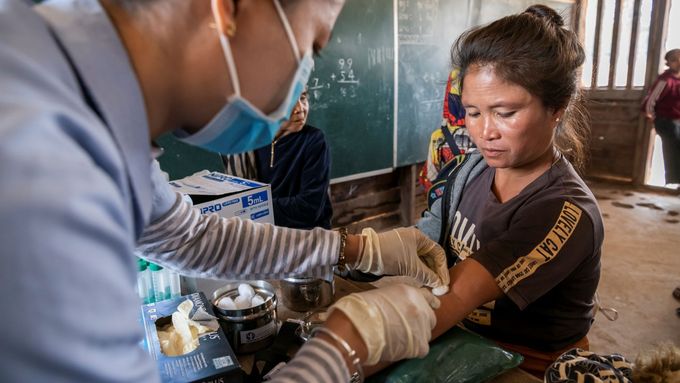Parasitic Worms and Liver Disease in Rural Laos
20.03.2024
A study published yesterday by Swiss TPH and partners in Lao PDR has revealed high rates of Steatotic Liver Disease in a rural region where liver fluke infections and diabetes are prevalent. Surprisingly, an infection with parasitic worms was inversely associated with the prevalence of Steatotic Liver Disease. The study sheds some light on the important interplay between infectious and non-communicable diseases.

Researchers analysed data from 21 rural villages, results showed that 27% of the rural population presented with Steatotic Liver Disease. (Photo: Olivier Brandenberg/Swiss TPH)
Shedding light on the SLD prevalence
Steatotic Liver Disease (SLD), also known as fatty liver disease, is a condition characterised by the accumulation of fat in the liver cells. SLD normally does not cause immediate symptoms but can lead to fatigue, weight loss and abdominal pain and ultimately to liver damage such as cirrhosis or liver cancer. SLD is on the rise worldwide, mainly linked to insulin resistance and obesity. The understanding of SLD in particular in interaction with infectious diseases remains however limited.
In Lao People’s Democratic Republic (Lao PDR), infections with Opisthorchis viverrini liver fluke – a parasitic worm transmitted through consumption of raw fish – as well as type 2 diabetes are common, and severe liver morbidity such as bile duct cancer is frequent. Data on SLD prevalence in the country was however lacking to date. In this study, Swiss TPH in collaboration with partner institutions in Lao PDR and Germany aimed to estimate the prevalence and explore determinants of SLD in the rural southern part of the country.
The researchers analysed data from 21 rural villages, taking into account normal weight as well as overweight populations based on their body mass index (BMI). Results showed that 27% of the rural population presented with SLD. “Our findings reveal high rates of SLD particularly among overweight individuals – nearly 40% of them had SLD – and women," said Anousin Homsama, PhD candidate at Swiss TPH and first author of the paper. “The prevalence is high also in comparison with other countries is South East Asia.” The study was published yesterday in the peer-reviewed journal Annals of Medicine.
Protective effect through parasitic worms?
An unexpected result of the study was that the presence of O. viverrini infections was inversely associated with SLD in people with normal weight. “This was a very surprising result. It indicates that a liver fluke infection might protect people with a normal weight from SLD. In people with overweight, we could not observe this effect.” said Peter Odermatt, Head of the Helminths and Health group at Swiss TPH. “This might be explained by the nutrient consumption of the parasitic worms, which live in the human bile duct and consume bile, which might reduce the fat content sufficiently in individuals of normal weight.”
More research needed on double disease burden
Many low- and middle-income countries face a steep rise in both infectious and non-communicable diseases. This double disease burden poses a strain on many healthcare systems and the interplay between the two is not always well established.
“We know that many infectious diseases have an effect on non-communicable conditions and vice versa, but we don’t always understand the causality,” said Nicole Probst-Hensch, Head of the Department ‘Epidemiology and Public Health’ at Swiss TPH. “We urgently need a better understanding of the complex interplay between these diseases as well as the manifold underlying factors linked to genetics, lifestyle, and environmental exposures.”
Longstanding partnership in Lao PDR
Swiss TPH has been active in Lao PDR in controlling different parasitic worm infections for 25 years in particular with the Lao Tropical and Public Health Institute. In addition to the training of health professionals in the Lao PDR and the exchange of experts, joint research projects are at the forefront of the partnership.
Publication
Anousin Homsana, Phonesavanh Southisavath, Kerstin Kling, Jan Hattendorf, Savina Vorasane, Daniel Henry Paris, Somphou Sayasone, Peter Odermatt & Nicole Probst-Hensch (2024) Steatotic liver disease among lean and non-lean individuals in Southern Lao PDR: a cross-sectional study of risk factors, Annals of Medicine, 56:1, DOI: 10.1080/07853890.2024.2329133
Contact

Nicole Probst-Hensch
Professor, PhD (Pharmacy and Epidemiology), MPH
Scientific Group Leader, Head of Department
+41612848378
nicole.probst@swisstph.ch

Peter Odermatt
Prof. Dr.
Head of Unit, Group Leader
+41612848214
peter.odermatt@swisstph.ch
Stay connected
Subscribe to our newsletter and get all the latest research news, project updates, course and event listings from Swiss TPH.